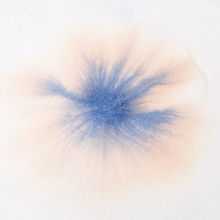Fountain pen ink

Fountain pen ink is a water-based ink intended for use with fountain pens.
Composition

Because fountain pens operate on the principle of capillary action, ink for them is almost exclusively dye-based. Pigment-based inks (which contain solid pigment particles in a liquid suspension) tend to clog the narrow passages of the pens.[1] Some pigmented inks do exist for fountain pens, but these are uncommon. India ink, a carbon pigment-based ink, also contains a binder (such as shellac), which can quickly clog such pens.[2] The ideal fountain pen ink is free-flowing, free of sediment, and non-corrosive. These qualities may be compromised in the interests of permanence, manufacturability, and in order to use some widely available dyes.[3]
A form of ink that predates fountain pens by centuries is Iron gall ink. This blue-black ink is made from iron salts and tannic acids from vegetable sources. Prior to the ready availability of manufactured ink, iron gall ink was often home made. Stark's ink was one ink recipe, named after the Scottish chemist who devised it after spending several decades experimenting with hundreds of formulations.[4]
Iron gall ink was used in fountain pens when they were invented, but has the disadvantage of causing corrosion to metal parts. Modern formulations of Iron gall ink are somewhat less corrosive and are still occasionally used in applications that require permanence.
Red inks usually contain the dye Eosin. Blue inks often contain Triarylmethane dye. In addition to water, the non-dye components (collectively referred to as the vehicle) might include polymeric resins, humectants to retard premature drying, pH modifiers, anti-foaming agents, biocides to prevent fungal and bacterial growth,[5] and wetting agents (surfactants). Surfactants reduce the surface tension of the ink; distilled water has a surface tension of 72 dyn/cm (72 × 10−3 N/m), but the desirable value for ink is between 38 and 45 dyn/cm (38 to 45 × 10−3 N/m). If the ink's surface tension were too high, then it would not flow through the pen; if it were too low, then the ink would run out of the pen with less control.[6]
Some users mix inks to create their own colour shades although mixing some combinations will lead to problems caused by chemical reactions between the different components. This may sometimes occur even when mixing inks from the same manufacturer.[6]
Delivery

Fountain pens carry ink within the barrel, traditionally either inserted at one end in bulk with a syringe or eyedropper pipette, or through a mechanical filling system built into the pen (such as a piston or vacuum-pump mechanism). For such fountain pens, ink is available in bottles which will typically refill an individual pen many tens of times. Simpler fountain pens use pre-filled ink cartridges, although in many cases the cartridge can be replaced with a converter which replicates the mechanical filling action of more expensive pens. The cost per millilitre of ink tends to be lower for bottled ink than for cartridges.
Care must be taken when using some vintage pens manufactured from celluloid, as this material can become stained by long–term exposure to some inks.[7]
Manufacturers
Most fountain pen manufacturers also provide a brand of ink; for example Parker sells 'Quink', and Sheaffer sells 'Skrip'. The recent resurgence of fountain pen use has also created a market for companies that specialize in ink, such as the British company Diamine and the American company, Noodler's Ink. These manufacture ink in dozens of different colours.
Durability and security
In the late 20th century, particular attention has been paid by ink manufacturers to the durability of their products against the effects of time, moisture, and efforts at forgery or falsification.[8] Some of these inks use pigments - the solid pigment particles lodge between the cellulose fibers that make up the paper and are unaffected by attempts to remove them with solvents.[8] Other inks use dyes that chemically bond with the paper's cellulose, and which likewise resist removal by solvents. A disadvantage of the dye inks is that, if spilled, they will form irremovable stains on clothing made from cotton, which also contains cellulose.[6] Also, some "secure" inks are vulnerable to removal using powerful infra-red lasers.[8]
References
- ↑ Fountain pen inks aren't all the same Retrieved 2011-02-20.
- ↑ A Few Notes About Fountain Pens. Retrieved 2011-02-20.
- ↑ Richard Binder on Ink. Retrieved 2011-02-16.
- ↑ Carvalho, David Nunes (1904). Forty Centuries of Ink. Banks Law Publishing Company. p. 122.
- ↑ "Ink chemistry". Chemistry World (Royal Society of Chemistry). March 2003.
- ↑ 6.0 6.1 6.2 Marcus, Glenn. "Fountain Pen Ink". Glenn's Pens. Retrieved January 25, 2013.
- ↑ Nishimura, David. "Discoloration and its causes". The Vintage Pens Website. Retrieved January 25, 2013.
- ↑ 8.0 8.1 8.2 "Making ink bulletproof". The Economist. 10 December 2009.
External links
| ||||||||||||||||||||||||||||